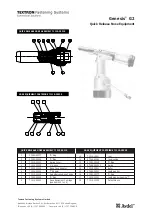
-32-
Model W1745W (For Machines Mfd. Since 9/16)
O
PE
R
ATI
O
NS
Surface Planing
The purpose of surface planing on the jointer is to make
one flat face on a workpiece (see
Figures 45–46
). This is
a necessary step when preparing a workpiece to be run
through a thickness planer when squaring stock.
To surface plane on jointer, do these steps:
1.
Inspect stock to ensure it is safe and suitable for the
operation (see
Stock Inspection & Requirements
sec-
tion).
2.
Set infeed table height to desired cutting depth for
each pass.
IMPORTANT:
For safety reasons, do not exceed a cut-
ting depth of
1
⁄
8
" per pass when surface planing.
3.
Set fence to 90˚.
4.
Start jointer.
5.
Place workpiece firmly against fence and infeed
table.
IMPORTANT:
To ensure workpiece remains stable dur-
ing cut, concave sides of workpiece must face toward
table and fence.
6.
Feed workpiece completely across cutterhead while
keeping it firmly against fence and tables during the
entire cut.
IMPORTANT:
Keep hands at least 4" away from
cutterhead during the entire cut. Instead of allow-
ing a hand to pass directly over cutterhead, lift it up
and over cutterhead, and safely reposition it on the
outfeed side to continue supporting workpiece. Use
push blocks whenever practical to further reduce risk
of accidental hand contact with cutterhead.
7.
Repeat
Step 6
until entire surface is flat.
Tip:
When squaring up stock, cut opposite side of
workpiece with a planer instead of the jointer to
ensure both sides are parallel.
Figure 46.
Typical surface planing
operation.
Figure 45.
Illustration of surface planing.
Removed
Surface
Failure to use push blocks when surface
planing may result in cutterhead
contact, which will cause serious
personal injury. Always use push blocks
to protect your hands when surface
planing on the jointer.
If you are not experienced with a
jointer, set depth of cut to "0", and
practice feeding workpiece across tables
as described. This procedure will better
prepare you for actual operation.
Removed
Surface
















































